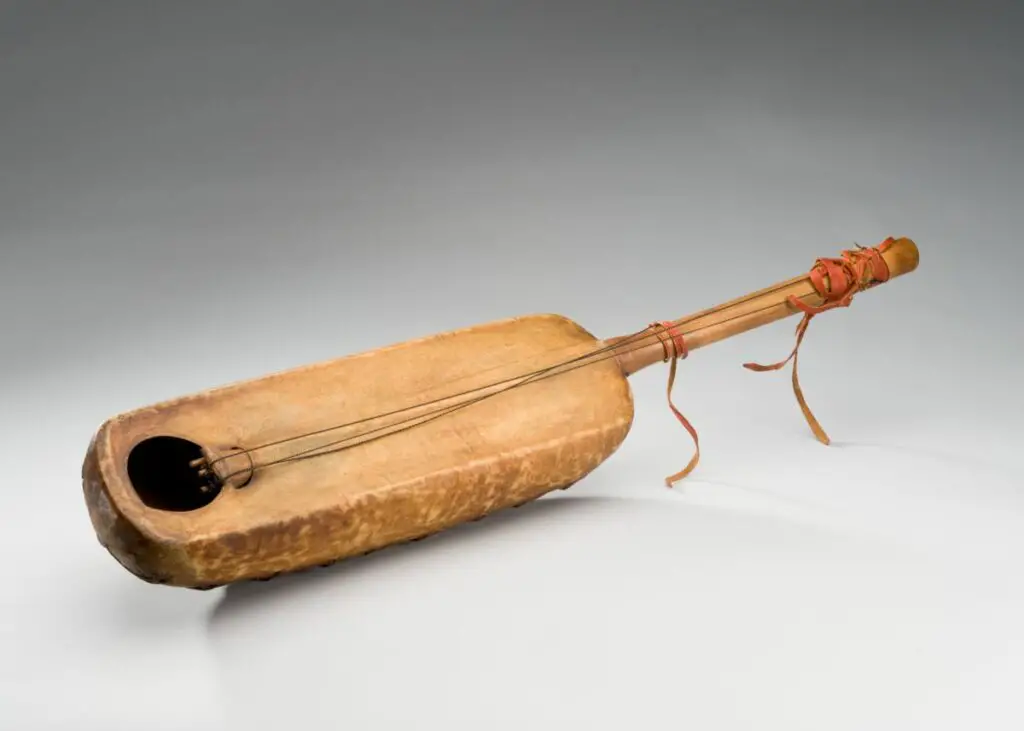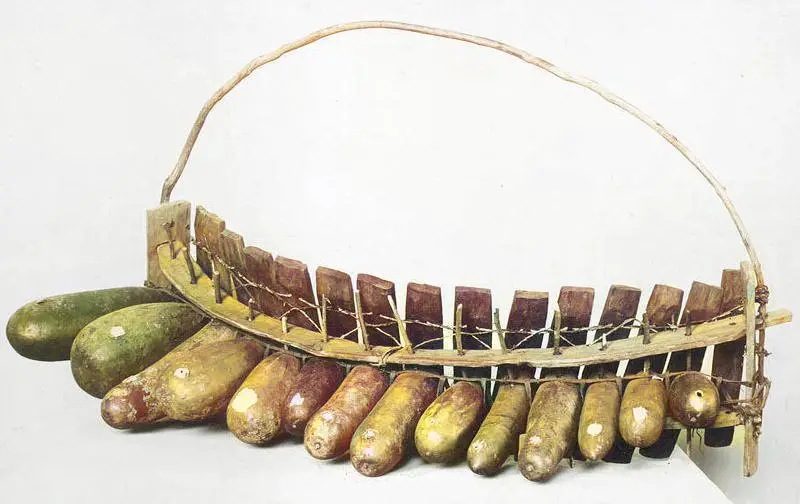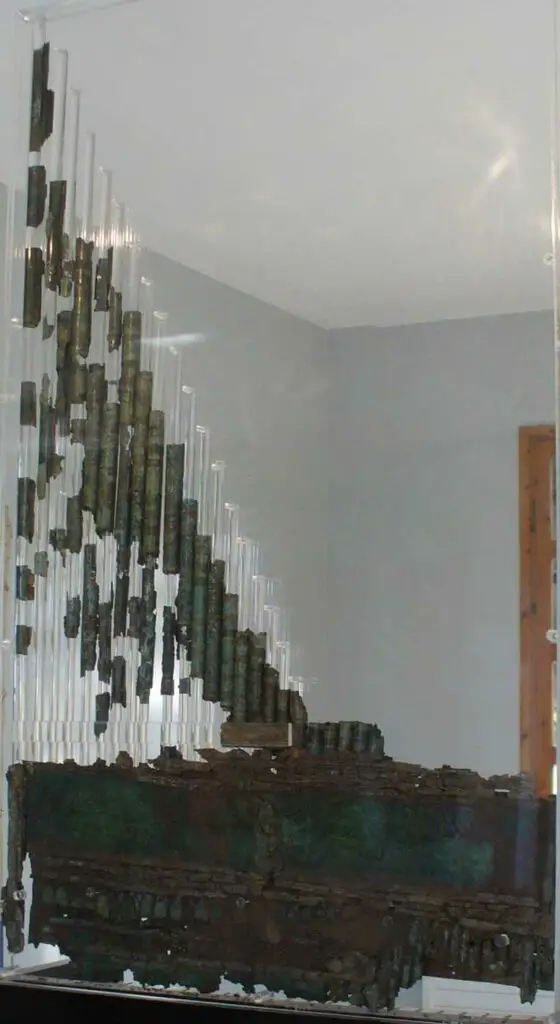These are truly ancient musical instruments. Most instruments on this list are over 3000 years old and many are much older. I’ll show you some of the artifacts and their history, and at the very end of this list, I will show you a special instrument.
Bone Flute

This flute is the oldest instrument ever found. It’s estimated that it is 60.000 years old, and was made by Neanderthals in Europe. It was discovered in the Divje babe cave in Slovenia, and the flute is made out of a bone from a Cave bear. An animal that went extinct 24.000 years ago. It’s on display at the National Museum of Slovenia if you want to see it for yourself.

This finding proves that the flute is the earliest instrument made by humans, at least that we’ve found so far. Flutes like this bone flute can be preserved in caves because some caves are really dry, which makes it so that the material doesn’t break down.
Lute

Do you recognize the shape of the Lute? Going back in history, it’s the Guitar’s ancestor, making its earliest appearance more than 5000 years ago in Ancient Mesopotamia. The Lute in the image was collected in West Africa in 1951. And although the one in the image may be quite recently made. You can see the resemblance in this much older ancient Egyptian painting below.

This painting was found in the Lost Tomb of Nebamun, depicting lute players and it’s estimated that the drawing is from 1350 BC. Though prior to this painting, Lute instruments had existed for 1700 years.
The lute instrument is made out of carved wood creating the resonance chamber, and the strings are made out of gut from an animal’s stomach. In fact, gut strings were standard on most ancient string instruments, and they used to be standard for guitars as well. You can still buy gut strings but they are very expensive.
Didgeridoo

Rock paintings in Northern Australia indicate that the Didgeridoo is 1500 years old. But the didgeridoo is not only ancient. It’s also mostly made by nature herself. Traditional didgeridoos are made by termites, which eat the soft tissue (heartwood) inside the Eucalyptus tree, creating hollow branches that can then be broken off and played with.
Many think that the instrument is much older than 1500 years old and it possibly is. As it’s created naturally, it could very well have been used before it was ever put on rock paintings. But that is the oldest record of it.
Lyre

This instrument is called a Lyre, and in the image above you can see one of the oldest ones in the world at 4,500 years old. It’s called the Silver Lyre and belongs to a collection called the Lyres of Ur. Which is a set of 3 Lyres and 1 Harp recovered from an ancient royal burial site in Iraq in 1929.
The Lyres in this collection are the oldest surviving string instruments in the world. Meaning that some instruments found at archaeological sites are only found in fragments unlike these.
The Lyre is made out of wood, with a bull’s head made out of metal, and the bottom part is a soundbox that amplifies the sound of the strings.


Ocarina & Vessel Flutes

This Mexican Vessel Flute is from the 7th-9th century, but the instrument’s history is believed to date 12,000 years back.
The shape of the flute, and where the holes are placed are irrelevant to its sound, and only the size of the flute matters. This is the reason why a flute shaped like a bird works, and how this type of instrument is so varied in its shapes and styles. For example, the Ocarina which is also a vessel flute has a completely different shape but works exactly the same way.


This type of flute has traditionally been made with Clay, Coconut, Stone, or Wood and its origins are not from a single region, but rather have emerged naturally all over the world thanks to its simplicity.
Frame Drums

In the image above, you can see one of the more decorated variants of a frame drum called a Shamanic Sami Drum. This specific type has a recorded history dating back to the 12th century. But there are many more variations of frame drums and the first ones originated in Mesopotamia and were also played in Ancient Egypt.
A key feature is that they are wider than they are deep. Which makes them quite slim. They’re made out of a hide stretched out over a wooden frame which is then drummed on with hands, fingers, or a mallet. The design is in fact still very popular and you can buy one of these ancient-styled drums for very little money.
Clappers

This ancient Egyptian clapper instrument is about 2000-3000 years old. The image features the upper part of the clapper, and there was previously a handle attached to it. A clapper is pretty much what it sounds like, just like when we clap our hands instead, this instrument consists of two objects that when smashed together create a clap-like sound.
Clappers were some of the earliest percussion instruments in Ancient Egypt and were used during activities such as rituals, funerals, and Banquets. This instrument has existed in many forms all over the world, for example, Aboriginal people in Australia have used two boomerangs and Hawaiians have used small rocks (ili ili) to create a similar sound.
In today’s world, it may be uncommon to find a clapper that looks like one from Ancient Egypt. But the Castanet is a form of clapper that is still quite popular and well-known.


Bullroarer

The Bullroarer is one of the oldest instruments ever, dating back to 18.000BC (20.000 years ago). It consists of a thin slab of wood, attached to a string that when whirled around in a circle, creates a roaring sound that can be heard from great distances. The sound is produced due to the spinning of the wood and can be modulated by whirling the instrument faster or slower, as well as by adjusting the length of the string.
It’s been used by Amazonian Shamans, Aboriginals, North American Indians, and many other groups of people. By Aboriginals, it has been a sacred instrument that only initiated men would be allowed to hear. If outsiders heard the sound of the Bullroarer, they were sentenced to death.
Sistrum

If you think this looks like something made out of plastic. Look again! This is a 2300-year-old rattle from Ancient Egypt, also known as a sistrum. Within the hole at the top, there would have been a tiny cymbal, or disk, that rustled when the player shook it. Many Sistrums from Ancient Egypt share a similar design.
The god depicted on the Sistrum called Hathor was the mother of Ra and Horus and she represented music, dance, joy, and love. This instrument was used in Hathor ceremonies.
Maracas

Rattles that are similar to Maracas, have existed for millennia in Africa, the Pacific Islands, and the Americas. They are basically a shaker on a stick and were traditionally made from Coconut shells or dried Calabash, which were then filled with dried beans, seeds, or pebbles. The smaller the Maracas are, the higher the pitch is.
They’ve been used for creating rhythms for dancing, and also by shamans during ceremonies.
Pan flute

The panflute originates from Ancient Greece in 3000-2000 BC. It was made out of canes or clay pipes, that were waxed at the ends to create a chamber for the sound to resonate in. Waxing the ends also lowers the octave of the notes by 1 thanks to a standing wave being created. The flute is blown on the edge, which makes the air circle around in the pipe, creating its iconic sound.
The name of the Pan flute comes from Pan, the Greek god of nature and the instrument was named in honor of him.
Scrapers/Rasps

The rasp is not only a tool but also a musical instrument that’s been used since ancient times. It’s been used in America since 200 BC, but its history stretches further back to Ancient Egypt where it’s been used since 1200BC.
The instrument was made from wood, bones, clay, or metal which the maker then put notches in. So that when swiped over with a stick, would create a percussive sound thanks to the friction generated by the rugged surface. But this instrument has not only been used for music. In Thailand, rasps have been used to imitate the croak of frogs, which makes them gather in one place in order to hunt them easily.


Bow Harp


You’re looking at an Ancient Instrument called a Bow Harp from 2030–1640 B.C. It was a popular instrument in Egypt back in the day and they even played it in bands. The harp had 5 strings and the larger bottom portion of it that looks like a shovel used to be covered with animal skin or parchment creating a resonance chamber.
This instrument closely resembles the musical bow, which came before it. Which was just a modified Bow (yes, a hunting bow) with one string and a resonance chamber attached to the bottom.
Xylophone

This is a Central African Xylophone from the 19th century. But the instrument has a history dating much further back to the 9th century. While this instrument has been popular in Africa, its origins are debated. Some claim it’s from Africa, and some claim it’s from Asia, however. There’s a possibility that the instrument was created independently on two different continents.
Nonetheless, it’s an extremely old instrument.
Its resonance chambers which you can see at the bottom are created from Gourd, which is hollowed out, and the gourd is then attached to wood bars, which when struck with a mallet create the tones that the instrument is famous for.

Trumpet

In the image above, you can see Tutankhamun’s trumpets, which are 2 trumpets that were found in Tutankhamun’s burial chamber in Egypt. They are over 3000 years old and are made out of wood, gold, and silver. They are still fully functional and were even used in a live performance on a BBC radio broadcast in 1939. When one of the trumpets was played for a listening audience of 150.000 people.
Tutankhamun’s trumpets truly are among the oldest trumpets ever found. But there have been other variants that share a similar age, such as trumpets made out of horns of animals (Shofar), large seashell trumpets, and bronze trumpets.
The trumpets have been on display at the Egyptian Museum in Cairo, and although one of the trumpets was stolen in 2011, it was mysteriously returned a few weeks later.
Gong

The Gong is a percussion instrument originating from the southeast and east Asia and the oldest gong ever found dates back to somewhere between 202 BC and 220 AD.
It’s struck with a mallet or a hammer to produce an intense sound that can range from a clean tone to a long-drawn-out crash. The sound levels can reach up to 106db and possibly beyond. Which is equivalent to hearing a jet plane taking off from 1000ft (305m).
Gongs have been, and are in use in Chinese and Buddhist temples to gather people and to notify the inhabitants when it’s time to wake up and when to go to bed. But there have been many more use cases for this instrument, such as playing musical pieces with multiple gongs, and for dispersing people with its loud sound.
Sheng

Have you ever seen this instrument before? It’s a type of mouth organ called a Sheng, which is one of China’s most ancient instruments dating back to 1100 BC (3100 years).
The Sheng is related to the Harmonica, which is apparent in that it can produce sound on both the exhale and the inhale. The player covers the holes, like on a flute, to produce different notes, and because it’s polyphonic, multiple notes can be played at the same time to form chords.
You may think there are a lot of pipes, and you’re right. There are 13 pipe versions all the way up to 36. And there are both traditional scale versions as well as chromatic versions
The pipes are made out of bamboo and the rest of the instrument is made out of wood. The reeds were also made out of bamboo in the past, but nowadays metal is used. A reed is a thin strip of material that vibrates as air goes through it.
Bells

This ancient Chinese Zhou Bronze bell from the 5th Century BC, may look deformed or oval. But this shape was entirely made on purpose. Instead of having a round bell, the oval shape produces two tones at the same time instead of one. Bells were a signal of high status in China and the Chinese perfected the art of making them.

They didn’t use only one bell, but rather sets of bells to be able to play many notes for musical pieces. The notes were inscribed into the bells to help the players assort them.
Chinese bellmaking happened way before the industrial revolution in Europe, but in China, they allready had early working factories set up to manufacture bells like these 2800 years ago.
Jaw Harp

A jaw harp can be made out of both bamboo and metal, and the instrument is as old as 1800 BC. The name is rather strange, as the instrument has nothing to do with a harp. Instead, it’s put to the mouth and the flexible part called a tongue is pulled. The instrument uses the mouth as a resonator, and the player can affect the sound by moving the mouth and tongue around.


Organ

This Ancient Organ from Greece is about 2000 years old. It’s called a water organ or Hydraulis, because it used water to function. The water was supplied through elevated pipes, which drew water from an uphill spring, and this water was then mixed with air to deliver the air into the pipes that made them play.
It was the first keyboard instrument in the world, having keys just like our modern keyboards and it was invented by the Greek scientist named Cstesibius who lived in the 3rd century BC.
The Oldest Musical Instrument
Maybe you’re wondering, what the oldest musical instrument is, and I’ve got the answer for you.
The oldest musical instrument is singing. By studying fossils, it’s been determined that humans had the ability to sing 530.000 years ago, as they had the same horseshoe-shaped hyoid bone as modern humans, enabling them to sing.
By applying the same principles when studying birds. It’s also been determined when birds first had the ability to sing which was 66 million years ago.

Scientists came to this conclusion after finding a fossil of the bird Vegavis iaai syrinx in Antarctica and studied its vocal organs. Though it wouldn’t have been a beautiful melody back then, more of a honk. This bird is a distant relative to gees and ducks, maybe that explains it.
Many More
There are many more ancient musical instruments that haven’t made their way onto this list. In the future, there may be more instruments added. But for me (the writer) of this article, just wanted to present you with some of the most interesting ones, as well as the oldest musical instruments.
Thanks
I wanna give thanks to the Metropolitan Museum of Art for having such an open and accessible library of images to use. This article would have been extremely hard to make without their image library. I choose to not credit the images and instead put this thanks here. Though they are not endorsing this work and I am not in partnership with them in any way.

